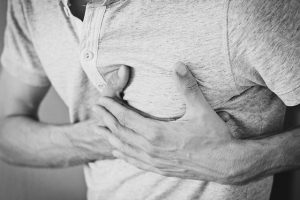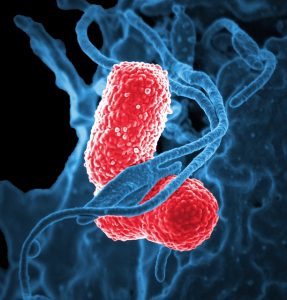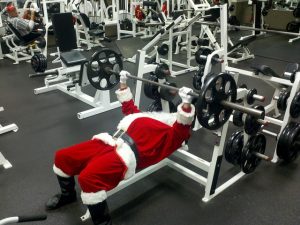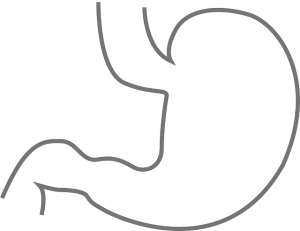
Pain under your left breast or rib cage can be really scary, especially if you’re worried you might be having a heart attack or other medical emergency. However, most cases of chest pain under the left breast and rib cage area are caused by benign or easily treatable conditions.
In this decision guide, we’ll first help you determine if your chest pain could be an emergency. Then, we’ll review different kinds of chest pain under the left breast, the potential causes, and how you should address the issue.
Chest Pain Under Left Breast: Is It an Emergency?
You may think: chest pain under my left breast? Time to call the ER! However, if you have pain under your left rib cage, it's unlikely, though possible, that you are experiencing a cardiac emergency.
The main worry people have when experiencing pain under the left rib cage is that they are having a heart attack. While a heart attack won’t always have the same symptoms, here are some indications your pain under the left rib cage could be heart-attack related:
The pain from a heart attack (or myocardial infarction) is typically not sharp or localized. Instead, it can feel like crushing, burning, squeezing, or tightness deep within the chest. It is also typically spread over a wide area of the chest (and potentially the arms, neck, and upper back). In general, you cannot relieve the pain by changing positions, breathing, stretching, etc. The pain typically increases gradually over several minutes.
Here are some other potential symptoms of a heart attack:
- Sudden-onset vomiting or nausea
- Sweating or flushing
- Light-headedness, fatigue, or confusion
- Shortness of breath
- Tingling, numbness, weakness in arms
- Fever
If you suspect a heart attack, call 911 or go to the emergency room.
Be aware that while your primary concern may be a heart attack, there are some other medical emergencies that can also cause chest pain under the left breast. We’ll briefly go over these here.
Pulmonary embolism: A pulmonary embolism occurs when a blood clot gets lodged in one of the arteries of the lungs, typically traveling from somewhere in the legs. Major clots can be life-threatening. These are the symptoms:
- Shortness of breath (main symptom)
- Sharp chest pain under the left breast (or right breast if the clot is on the right side) that extends into the arm, shoulder, neck, and/or jaw and gets worse with breathing, coughing, or exertion
- Fever, sweating
- Light-headedness, fainting, dizziness
- Heart palpitations
- Coughing up blood or bloody sputum
- Pain or swelling in the leg (typically the calf)
Pneumothorax: A pneumothorax, or a collapsed lung, can be caused by lung disease or chest injury, but it can also occur apparently spontaneously. While a small pneumothorax may go away on its own, a severe pneumothorax can inhibit the flow of blood through the chest and be life-threatening. The main symptoms are:
- Sudden, sharp chest pain on one side of the body
- Shortness of breath
If you think any of the above emergency situations might apply to you, seek medical attention immediately.
Next, here are some indications that you are probably not having a heart attack:
- You’re feeling a stabbing, sharp pain under the left breast
- You can pinpoint the location where the pain is coming from
- Pain increases from breathing or coughing
- Pain comes and goes in sudden, shocking stabs
- Chest pain improves with exercise
- Pain follows eating spicy or heavy foods; you may also have a sour taste in your mouth
- Changing positions relieves the pain
Note that some of these symptoms may be caused by chronic cardiac conditions. So if you are experiencing pain under the left rib cage, you should make an appointment to see your primary care physician to get checked out even though you most likely don’t need to go to the emergency room.

Moody doctor will see you now.
Types of Pain Under Left Rib Cage
Even if you feel confident it’s not an emergency, you probably want to know what could be causing chest pain under your left breast. The first thing you’ll want to consider is what type of discomfort you’re feeling.
Are you feeling sharp pain under the left rib cage? Dull pain under the left breast? A stabbing or burning sensation? The type of pain you are feeling on the left side of your chest can help you narrow down the potential causes, because chest pain under the left breast can be caused by a wide array of underlying complaints.
Also think about the onset of your symptoms. Was the pain preceded by physical activity? Stress? A Big meal? These kinds of questions will help you figure out what your pain might be caused by.
Here’s a table describing different types of chest pain under the left rib cage and some potential conditions on the right. Click on a condition to be taken to a more in-depth description of that condition.
| Type of Chest Pain | Potential Conditions |
| Sharp/stabbing; worse with breathing | |
| Sharp/stabbing; not worse with breathing |
Angina (especially in women) |
| Pain accompanied by uncomfortable sensation of pressure, tightness, or squeezing | |
| Pain localized to a specific area; tender to pressure | |
| Burning chest pain |
Cardiac Causes of Chest Pain
In this section, we’ll focus on causes of chest pain under the left breast associated with the heart. While discomfort due to heart disease often manifests as a dull pain under the left breast that feels like uncomfortable pressure, it can also be a burning or even stabbing pain depending on the condition. Conditions are listed alphabetically.
Angina
Angina refers to the discomfort caused when your heart muscle isn’t getting enough oxygen. It is typically caused by a narrowed or blocked coronary artery due to plaque buildup and is a warning sign of heart disease.
Kind of Chest Pain: Uncomfortable feeling of squeezing or pressure; may radiate throughout the upper body to the shoulders, arms, neck/jaw, and back. Can sometimes also feel like indigestion/heartburn. Pain typically comes and goes and is often made worse by exertion. Women may also experience angina as a sharp chest pain under the left breast or breastbone.
Other Symptoms:
- Shortness of breath
- Sweating
- Dizziness
Angina symptoms may be different in women than in men. In addition to chest pain and also symptoms, a woman may also feel:
- Nausea and vomiting
- Abdominal pain
Actions: The pain of angina may feel very similar to that of a heart attack, and often sends people to the emergency room (better safe than sorry!). However, it’s actually a warning sign of heart disease. Your doctor will probably recommend medication to help widen the arteries, as well as lifestyle changes. You may also need a procedure like stenting or, in serious cases, coronary artery bypass surgery.
Aortic Valve Stenosis
Aortic valve stenosis refers to the narrowing of the aortic valve (the valve that allows oxygen-rich blood to flow from the heart into the aorta). The narrowing of the valve causes the heart to have to work harder, potentially leading to eventual heart failure. Aortic valve stenosis can be congenital or it can caused by infection or calcium deposits that form as you age.
Kind of Chest Pain: Pressure or tightness. May also feel like burning. Can radiate to the arms, shoulders, and neck.
Other Symptoms: Minor stenosis typically has no symptoms. If stenosis becomes more severe, chest pain on the left side under the breast and the following additional symptoms may appear:
- Dizziness/fainting
- Irregular heartbeat
- Fatigue and shortness of breath
Actions: Minor aortic valve stenosis will be monitored by a physician, who may recommend lifestyle changes to help protect your heart. Severe stenosis may require valve replacement, an open-heart surgery.
Coronary Artery Disease (CAD)
Coronary artery disease occurs when plaque builds up in the walls of the arteries that bring blood to the heart. This causes the arteries to narrow, which limits blood flow to the heart and deprives the heart of oxygen. This can lead to heart attacks and heart failure. It is the most common type of heart disease and the most common cause of death for both men and women in the United States. It is typically related to lifestyle factors like smoking, lack of physical activity, and unhealthy diet.
Kind of Chest Pain: Pressure or squeezing chest pain; may also feel like burning. May radiate to the left shoulder, the arms, back, jaw, and neck. Physical exertion or stress often triggers the pain.
Other Symptoms:
- Shortness of breath
- Irregular heartbeat
- Nausea
- Fatigue
- Dizziness
- Weakness
Actions: CAD has serious consequences if left untreated. However, risk of complications can be lowered dramatically through lifestyle changes and medication. Surgery may also be needed to clear plaque from the arteries and restore blood flow to the heart.

Mmmm, the sweet taste of lifestyle changes.
Heart Attack (Myocardial Infarction)
A heart attack occurs when one of the arteries in the heart becomes completely blocked, depriving part of the heart of oxygen.
Kind of Chest Pain: As mentioned above, the pain from a heart attack usually feels like a crushing, burning, squeezing, or tightness in the chest. It may radiate throughout the upper body, shoulders, arms, and neck. The pain is not really relieved or changed by shifting positions, breathing, or stretching. The pain typically increases gradually over a period of several minutes.
Other Symptoms:
- Sudden-onset vomiting or nausea
- Sweating or flushing
- Light-headedness, fatigue, or confusion
- Shortness of breath
- Tingling, numbness, weakness in arms
- Fever
Actions: If you are experiencing a combination of the above symptoms and suspect a heart attack, call 911 or go to the emergency room. Pharmaceutical treatment can decrease the damage done by a heart attack, but drugs typically need to be administered within 1-2 hours of the attack. You may also need bypass surgery. You will likely also need to make lifestyle changes and take medications to decrease risk of future heart attacks.
Hypertrophic Cardiomyopathy
Hypertrophic cardiomyopathy refers to the thickening of the heart muscle, typically between the ventricles. The thickening of the muscle makes it stiffer, which makes the heart work harder to pump blood. While many people with this condition remain asymptomatic, it can lead to abnormal functioning of the valves of the heart or decrease the size of one of the ventricles, which can cause symptoms including chest pain.
Kind of Chest Pain: Chest pain or pressure that appears during/after exercise or exertion, but may also occur at other times, like after meals
Other Symptoms:
- Shortness of breath (especially during exercise/exertion)
- Light-headedness and fainting (especially after exercise/exertion)
- Heart palpitations/irregular heartbeat
- Fatigue
Actions: See a healthcare provider, as untreated hypertrophic cardiomyopathy can have serious complications. Hypertrophic cardiomyopathy can normally be managed with medication, but surgery may be recommended. Be aware that this condition is sometimes misdiagnosed as exercise-induced asthma.
Mitral Valve Prolapse
Mitral valve prolapse means that the mitral valve (one of the valves in the heart) bulges backward into the left atrium of the heart instead of closing evenly over it. Sometimes this causes blood to “leak” back from the left ventricle to the left atrium. People with mitral valve prolapse often have no symptoms, and will never experience health problems related to the condition. Some may have a murmur or other symptoms, including chest pain. It can be a progressive condition, getting worse over time.
Kind of Chest Pain: Stabbing pains that come and go, sometimes with exertion but typically when at rest
Other Symptoms:
- A heart murmur or irregular heartbeat
- dizziness/lightheadedness/fatigue
- Shortness of breath
- Panic/anxiety
- Numbness/tingling in hands/feet
Actions: Serious mitral valve prolapse can have similar symptoms both to panic attacks and heart attacks, so patients may end up in the emergency room. If symptoms are more mild (heart murmur, etc) see a cardiologist. You may need medication or surgery in more serious cases to manage the condition.

Dr. Frog will see you now.
Myocarditis
Myocarditis is the inflammation of the heart muscle, most often caused by viral infection. Symptoms normally develop 1-2 weeks after an infection. It can also be caused by fungal or parasitic infection or by autoimmune disorders.
Kind of Chest Pain: Sharp/stabbing pain or feeling of pressure. May spread to shoulders/neck.
Other Symptoms:
- Shortness of breath: first from exertion, then at night while at rest
- Heartbeat irregularities
- Light-headedness and fatigue
- Painful or swollen joints
- Other signs of infection, like fever, headache, diarrhea, and sore throat
Actions: See a medical professional. They will conduct tests, and if you do have myocarditis, they will treat the underlying infection or cause and potentially prescribe medications to help your heart operate while you recover. You will likely need to rest and eat a low-salt diet. Most patients will make a full recovery in several months; a minority of patients will have chronic heart problems and may need a heart transplant.
Pericarditis
Pericarditis is the inflammation of the two thin, lubricated sacs of tissue that encase the heart. The cause is often unknown but it can be a complication of respiratory infection or of taking certain medications.
Kind of Chest Pain: Typically a sharp, stabbing chest pain on the left side under the breastbone or on the left side of the chest, but can also manifest as a duller pain and pressure. Leaning forward in a seated position often eases the pain. Coughing typically makes it worse. Pain may spread to left shoulder or neck.
Other symptoms:
- Fever
- Fatigue and weakness
- Shortness of breath
- Coughing
- Heart palpitations (irregular heartbeat)
Actions: Like several of the other conditions described here, the pain of pericarditis may send individuals to the emergency room due to the fact that its symptoms can sometimes resemble those of a heart attack. However, pericarditis usually resolves on its own within a few weeks unless there are complications to be addressed.
Pulmonary Hypertension
Pulmonary hypertension refers to high blood pressure in the arteries that move blood from the heart to the lungs. It can have a number of causes, including genetic abnormalities, lung disease, heart disease, autoimmune conditions, drug use, and even sleep apnea. This condition causes the heart to pump harder to move blood to the lung, which can ultimately cause heart failure if untreated.
Kind of Chest Pain: Pain/pressure towards the front of the chest
Other Symptoms:
- Shortness of breath with light exertion/activity
- Fatigue
- Fainting/lightheadedness
- Ankle/leg swelling
- Dry cough
- Coldness in the extremities due to poor circulation (or secondary Raynaud's)
Actions: Pulmonary hypertension is progressive (it gets worse over time) so seeking treatment early is important. Treatment will vary based on the cause of your pulmonary hypertension, but your doctor will likely recommend lifestyle changes and medication. In severe cases, your doctor may recommend surgery

Delicious, delicious lifestyle changes.
Lung and Respiratory Causes of Chest Pain
In this section we’ll describe some of the main causes of chest pain on the left side due to lung or respiratory issues. Respiratory causes of chest pain often manifest as a sharp pain under the left breast. Conditions are listed alphabetically.
Asthma
Asthma is a chronic condition in which irritation (which can be caused by a number of triggers, depending on the type of asthma) causes the airways to narrow and fill with mucus, making breathing much more difficult.
Kind of Chest Pain: You may experience chest pain before, during, or after an asthma attack. Before and during the attack, you may experience a feeling of chest tightness or pressure. Following an attack (especially the next day) you may feel soreness in your chest as a result of using accessory muscles to breathe.
Other Symptoms:
- Coughing (especially at night)
- Unusual shortness of breath
- Wheezing
- Fatigue and trouble sleeping
Actions: Because asthma is a chronic condition, it is important to be under the care of a physician. They will help you create a treatment plan to manage symptoms.
Pleurisy
Pleurisy (or pleuritis) is a condition in which the tissue encasing the lungs and lining the inner chest wall (the pleura) becomes inflamed. Pleuritis can be caused by a variety of underlying conditions but the source is often a bacterial or viral infection, like the flu.
Kind of Chest Pain: Sharp pain made worse by inhaling; you may also feel pain in your shoulders or your back. Your chest may also feel tender to external pressure.
Other Symptoms:
- Shortness of breath (primarily because taking deeper breaths is more painful).
- Cough
- Fever and chills
- Unexplained weight loss
Actions: If you repeatedly feel sharp pain under the left breast that gets worse with breathing, see a medical professional. A variety of tests may be performed to diagnose pleurisy. Your doctor may remove some of the pleural fluid with a needle for testing. The symptoms of pleurisy may be relieved through splinting, but to treat the condition the underlying source of infection or other condition will need to be addressed.
Pneumonia
Pneumonia is a lung infection caused by viruses or bacteria (and sometimes fungi or other infectious agents) in which the air sacs of the lungs fill up with fluid. It can occur in one or both lungs. Because it is typically accompanied by a host of other telltale symptoms, it will probably be pretty clear to you that your chest pain is from some kind of respiratory infection. Pneumonia is often a complication of the viral flu or the common cold.
Kind of Chest Pain: Sharp or stabbing, often on the side of the chest. Typically gets worse with coughing or deep breathing.
Other Symptoms:
- Phlegmy cough; your mucus may be red-brown, green, or have blood flecks
- Fever and chills
- Shortness of breath from chest congestion.
- Weakness and fatigue
- Gastrointestinal symptoms like nausea, vomiting, and diarrhea
- Headache
- Confusion (common in older patients)
Actions: If you think you have pneumonia, go to a doctor to manage treatment. Because pneumonia can have serious consequences if left unchecked, it’s best to be under the supervisory care of a physician. They can also prescribe antibiotics if they suspect the pneumonia is caused by a bacterial infection. With treatment, you’ll likely get better in 1-3 weeks.

Bacteria bad guys can cause pneumonia.
Pneumothorax (Collapsed Lung)
Pneumothorax occurs when air gets into the space between the lung and chest wall, causing part or all of the lung to collapse. It can be caused by chest injury, certain medical procedures, or lung disease. But sometimes the cause is unknown. Men are much more likely to have a collapsed lung than women.
Kind of Chest Pain: Sudden and sharp, on one side of the chest
Other Symptoms:
- Shortness of breath
- A severe pneumothorax may cause the following symptoms:
- Chest tightness
- Dizziness and fainting
- Fatigue
- Rapid heart rate
- Blueish color to the skin (from lack of oxygen)
Actions: While a small pneumothorax may go away on its own, a severe pneumothorax can inhibit the flow of blood through the chest and be life-threatening. If you suspect a collapsed lung, seek medical attention. Treatment typically involves inserting a tube to drain the air.
Pulmonary Embolism
A pulmonary embolism occurs when a blood clot forms in another part of the body (usually the legs), travels through the bloodstream, and gets lodged in one of the arteries of the lungs.
Kind of Chest Pain: Sharp chest pain that extends into the arm, shoulder, neck, and/or jaw and gets worse with breathing, coughing, or exertion
Other Symptoms:
- Shortness of breath (main symptom)
- Sharp
- Fever, sweating
- Light-headedness, fainting, dizziness
- Heart palpitations
- Coughing up blood or bloody sputum
- Pain or swelling in the leg (typically the calf)
Actions: Major clots can be life-threatening; seek medical attention.

Long flights can increase your risk of blood clots.
Musculoskeletal Causes of Chest Pain
This section reviews pain in the left rib cage due to damage to bones, cartilage muscles, and ligaments. If your pain is musculoskeletal in origin, you’ll likely have a specific area of pain in the left rib cage or pain under the left breastbone that’s tender to pressure.
A Broken, Fractured, or Bruised Rib
Trauma to the chest can cause rib injury, which naturally causes chest pain. Excessive coughing can also cause rib injuries in some cases. Most rib breaks are cracks or fractures; complete breaks are rare and very serious.
Kind of Chest Pain: Site-specific pain on one or more ribs (you will be able to pinpoint the general area); will most likely feel worse with pressure, with deep breathing, and when bending and/or twisting.
Other Symptoms:
- An injured rib may impede your breathing, which can lead to headache, dizziness, shortness of breath, and fatigue.
- Trauma strong enough to cause rib injuries can also sometimes damage internal organs and blood vessels, which could cause their own symptoms.
Actions: If you suspect a damaged rib or ribs, see your doctor. Broken ribs are primarily treated through rest and pain management so that you can continue to breathe relatively normally to lower your risk of developing pneumonia.
Costochondritis
Costochondritis refers the inflammation of the cartilage that connects your ribs to your sternum (or breastbone). The cause is often unknown, but it can be caused by strenuous exercise or lifting, intense coughing, chest injury, or viral infection.
Kind of Chest Pain: Typically a sharp pain in the breastbone area that gets worse when you apply pressure to the area. Pain will be increased by deep breathing or coughing and eased by rest and quiet breathing.
Other Symptoms: There typically are not other symptoms of costochondritis other than the pain.
Actions: This is one of the more benign causes of chest pain. Costochondritis typically goes away on its own within a few weeks. Treatment focuses on pain management. However, if you develop other symptoms like trouble breathing, a high fever, etc, you should follow up with a health care provider. Similarly, if pain does not resolve, your provider may perform a chest x-ray.
Pulled or Strained Chest Muscle
A strain or tear in the muscles and ligaments around the chest could be caused by a traumatic event or just from simple overuse, particularly related to sports or exercise.
Kind of Chest Pain: The chest pain will likely accompany weakness and get worse with certain motions, especially of the arms. You may also feel that the area is tender to pressure.
Other symptoms:
- Swelling
- Muscle spasms
Actions: If pain is minor, you can treat a pulled muscle at home with ice, rest, and over-the-counter painkillers. If pain is severe or does not improve, see a doctor; you may need physical therapy or other treatment.

Be careful, Santa Claus! Don't tear a muscle.
Digestive System Causes of Chest Pain
Issues in the digestive system can cause chest pain. Because both heart attack pain and digestive system pain can manifest as intense, burning pain under the left breast, digestive issues are often mistaken for a heart attack. However, if the pain seems impacted by your food consumption, the issue is probably digestive in nature.
Acid Reflux/GERD (Gastroesophageal Reflux Disease)
Acid reflux occurs when stomach acids move up into the esophagus, causing pain. If this is a chronic problem, you likely have GERD—a defect in the esophagus.
Kind of Chest Pain: Burning chest pain after eating that gets worse when you lie down and improves in an upright position. Often worse at night. Some people mistake the pain of severe heartburn for a heart attack. But if the pain follows eating a heavy or spicy meal or is improved by sitting upright, it’s most likely not a heart attack. You may also feel pain below the left rib cage area.
Other Symptoms:
- Hoarseness (from vocal cord irritation)
- Bitter or sour taste in mouth or throat
- Nausea
- Difficulty swallowing
- Dry cough
Actions: You can relieve occasional acid reflux by popping a couple of antacids. But a chronic issue can damage the esophagus if it's not addressed. Your doctor might prescribe a medication to reduce the amount of acid in your stomach. You will also likely need to make some lifestyle changes (especially dietary ones) to manage your symptoms.
Peptic Ulcers
Peptic ulcers are sores in the stomach or the first part of the small intestine. They develop when the mucosal lining of the stomach thins and gets irritated by stomach acids. A variety of underlying issues can cause ulcers, including H. Pylori infection.
Kind of Chest Pain: Burning pain that gets worse on an empty stomach and at night. You may feel pain below the left rib cage.
Other Symptoms:
- Difficulty digesting fatty foods
- Nausea/vomiting; vomit may look like coffee grounds
- Bloating
- Weight loss
- Appetite changes
- Dark/black stool (from bleeding)
Actions: It’s important to seek medical treatment because untreated ulcers can cause serious complications like tearing in the stomach, intestine, or blood vessels, and scarring that obstructs the digestive process.

This little organ can cause major chest pains.
Pain Under the Left Breast: Other Causes
This section has a few other potential causes of chest pain under the left rib cage.
Severe Anemia
Anemia means your body is not producing enough healthy blood cells. There are a number of causes of anemia, including nutrient deficiencies, genetic abnormalities (like sickle cell anemia), and rapid blood loss. This means your heart has to work harder to pump oxygen through your body. When anemia becomes severe, your heart may not get enough oxygen-rich blood, leading to chest pain.
Kind of Chest Pain: Feeling of pressure or tightness in the center of chest.
Other Symptoms:
- Intense fatigue
- Shortness of breath
- Heartbeat irregularities
- Persistent feelings of coldness
- Paleness
- Headaches and dizziness
- Trouble concentrating; irritation
Actions: While mild to moderate anemia is often not very serious and is typically easily treatable with supplements and/or lifestyle changes, long-term, severe anemia can have major consequences, like heart disease. If you suspect you are anemic, see a doctor.
Panic Attack
Panic attacks are intense, sudden-onset anxiety episodes lasting about 20 minutes to an hour, with unpleasant physical and emotional symptoms. They can be brought on by intense stress or the cause may be unknown. Repeated panic attacks are called panic disorder.
Kind of Chest Pain: Sharp/stabbing, lasting for short bursts. Pain is often directly behind the breastbone.
Other Symptoms:
- Feeling terrified, anxious, and out-of-control
- Feeling of dissociation or unreality
- Fast heartbeat and shortness of breath
- Feeling of choking
- Shaking/trembling
- Sweats and/or chills
- Numbness, tingling
- Abdominal pain or nausea
- Dizziness, lightheadedness
- Weakness
Actions: Many people confuse initially confuse panic attacks for heart attacks, particularly because panic attacks are so scary. However, the chest pain associated with a panic attack is typically different from a heart attack as it is sharp and intense, lasting in short bursts.
If you do have a panic attack, see a doctor. They will help you figure out coping strategies should the panic recur. If you have panic disorder, you will likely to treated with some combination of therapy and medication.
Shingles
Shingles, or herpes zoster, is a viral infection that causes a localized, painful rash, often on the side of the chest but sometimes elsewhere. It’s caused by the same virus that causes chickenpox. Anyone who has had chickenpox (or varicella) can get singles. Shingles is fairly common; about 1 in every 3 people in the US will get it at some point in their lifetime.
Kind of Chest Pain: Before the shingles rash surfaces, many people feel intense pain at the infection site. Because the rash often appears on the side of the chest, many people experience a band of tight, intense chest pain on one side as the initial symptom.
Other Symptoms:
- The main symptom of shingles is the rash itself, which, when it emerges is typically very painful. It typically blisters.
- Before or during the emergence of the rash, you may also experience chills, nausea, diarrhea, or stomach pain
- Swollen lymph nodes
- Headache and/or light sensitivity
- Fatigue
Actions: If you suspect shingles, get to the doctor as soon as possible after the rash appears. Shingles is rarely life-threatening, but if you catch it early enough you’ll be able to take antiviral medication, which will shorten the course of the infection and reduce the chance of ongoing complications.

Wrong kind of shingles.
Pain Under Left Breast: Action Points
If you’re feeling pain under your left breast, you may be worried that you’re experiencing a heart attack. The pain from a heart attack typically feels like a crushing or tight sensation. You probably won't be able to relieve the discomfort by changing positions, stretching, or breathing. If you suspect a heart attack, call 911 or go to the emergency room. However, most chest pains are not heart-attack related.
If you feel a sharp pain under your left breast, it’s probably not a heart attack. With that said, you should still probably make an appointment with your doctor just to get checked out. Any kind of chest pain under the left rib cage can be a cause of an underlying chronic issue in need of treatment even if it’s not an immediate medical emergency like a heart attack. Early treatment of such chronic conditions dramatically decreases the risks of complications further down the line.
In this guide, we went over most of the common causes of chest pain under the left breast to help you identify what the issue could be and what actions to take. Even if the cause of your chest pain is not serious, it’s important to consult with a medical professional.
What's Next?
Need help understanding your blood pressure reading? Let us explain!










